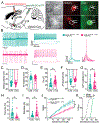Transcriptional and functional divergence in lateral hypothalamic glutamate neurons projecting to the lateral habenula and ventral tegmental area
- PMID: 34624220
- PMCID: PMC8812999
- DOI: 10.1016/j.neuron.2021.09.020
Transcriptional and functional divergence in lateral hypothalamic glutamate neurons projecting to the lateral habenula and ventral tegmental area
Abstract
The lateral hypothalamic area (LHA) regulates feeding- and reward-related behavior, but because of its molecular and anatomical heterogeneity, the functions of defined neuronal populations are largely unclear. Glutamatergic neurons within the LHA (LHAVglut2) negatively regulate feeding and appetitive behavior. However, this population comprises transcriptionally distinct and functionally diverse neurons that project to diverse brain regions, including the lateral habenula (LHb) and ventral tegmental area (VTA). To resolve the function of distinct LHAVglut2 populations, we systematically compared projections to the LHb and VTA using viral tracing, single-cell sequencing, electrophysiology, and in vivo calcium imaging. LHAVglut2 neurons projecting to the LHb or VTA are anatomically, transcriptionally, electrophysiologically, and functionally distinct. While both populations encode appetitive and aversive stimuli, LHb projecting neurons are especially sensitive to satiety state and feeding hormones. These data illuminate the functional heterogeneity of LHAVglut2 neurons, suggesting that reward and aversion are differentially processed in divergent efferent pathways.
Keywords: calcium imaging; electrophysiology; ghrelin; lateral habenula; lateral hypothalamic area; leptin; single-cell sequencing; ventral tegmental area.
Copyright © 2021. Published by Elsevier Inc.
Conflict of interest statement
Declaration of interests The authors declare no competing interests.
Figures







References
-
- Abrahamsen GC, Berman Y, and Carr KD (1995). Curve-shift analysis of self-stimulation in food-restricted rats: relationship between daily meal, plasma corticosterone and reward sensitization. Brain Research 695, 186–194. - PubMed
-
- de Araujo IE, Gutierrez R, Oliveira-Maia AJ, Pereira A, Nicolelis MAL, and Simon SA (2006). Neural Ensemble Coding of Satiety States. Neuron 51, 483–494. - PubMed
-
- Bagnasco M, Kalra PS, and Kalra SP (2002). Ghrelin and Leptin Pulse Discharge in Fed and Fasted Rats. Endocrinology 143, 726–729. - PubMed
Publication types
MeSH terms
Substances
Grants and funding
LinkOut - more resources
Full Text Sources
Molecular Biology Databases
Research Materials

